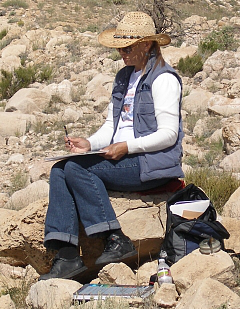
Marilynn Flynn’s artwork has appeared in numerous books, magazines, TV programs, DVDs, science exhibits, art shows and websites. Her paintings have been commissioned by such prestigious organizations as the Earth & Space Foundation, The Planetary Society and NASA. Her artwork is in the permanent collections of several museums, including the Kennedy Space Center in Florida, as well as in private and corporate art collections. Invited to join the NASA Fine Arts Program, she was a member of the art team for the tragic Challenger 51-L mission. She is one of the original founding members and the first elected secretary of the International Association of Astronomical Artists (IAAA).
She always wanted to be an astronaut and loves flying. She recently added aviation art to her portfolio, with an artistic tribute to aerial firefighters and the aircraft they fly. She also designs and manages several websites and webshops featuring her artwork.
“I want my art to convey that these are real places where it is not an impossible dream to live. I feel it is the natural and necessary course of human evolution to leave Earth and settle on other planets. In my artwork I portray these ideas by painting planetary landscapes from the viewpoint of a human explorer. I hope my paintings show the strange beauty of other worlds while educating viewers and inspiring future space travelers.”

In 1995 her painting of “Cosmic Cauldron” was selected as one of twenty paintings that were launched to the Mir space station, where it orbited Earth for several months as part of “Ars Ad Astra”, the first group art exhibit in space. Two of her sketches are also on the surface of Saturn’s moon Titan-engraved on a CD made by ESA which is attached to the Huygens lander.
Marilynn’s space art paintings are a blend of science fact, art and intelligent imagination. They portray her desire to explore other planets and her belief that it is the natural course of human evolution to migrate from Earth and live on them. Her artwork is known for it’s emphasis on the human element of space exploration.
Follows a selection of Marilynn’s work, accompanied by her description of the subject and notes on her creative process.

Venus – Seoritsu Short Stack
Looking west across the Seoritsu Farra, a chain of seven ‘pancake’ shaped volcanic domes on Venus. Their surfaces may have become fractured when molten lava below pushed up against a cooled, hardened crust, cracking the surface, then later subsiding. Some of the domes erupted so close together that they overlap each other. Beyond the domes, the beginning of the Alpha Regio uplift can be seen and in the distance a cloud from a volcanic eruption rises in the sky. ©1999

Astronaut Book of Hours: This painting is inspired by an illustration representing the month of April from a medieval ‘Book of Hours’ known as the Tres Riches Heures (The Very Rich Hours). In my version, the arches enclose icons representing things which service the International Space Station – an astronaut in an EVA suit and a Progress supply ship, floating in space among gold stars. The names of all the Space Shuttles are written in the top arch, and surrounding the name of the Space Station in the nottom arch are the acronyms for the major space agency partners. The International Space Station, backlit by the rays of the sun, is depicted in the center arch. Below, the castle has been replaced by a Space Shuttle and service structure (aka the Gantry) at the launch pad. The ‘nobility’ of the space program – the astronauts – are depicted in a blue flightsuit and orange launch suits. Medieval hats and veils have been replaced by snoopy caps and helmets. Attending them are technicians clad in “white room” apparel, who traditionally help prepare astronauts for a launch. On the right, a white room technician prepares to remove a helmet from a bag. In the background are other icons representing elements important to a launch, the “Astrovan” which carries the astronauts to the launch pad, and the “Countdown Clock”. © 2012.

I Love an Astronaut: Two affectionate astronauts in the ready room. This was inspired by a photo of an Apollo astronaut getting a smooch from his wife just before leaving to go to the moon. © 1988

East of Dahzbog: Jupiter hangs low on the horizon over a vast sulfur plain in the Dahzbog region on Io. A molten flow creeps downhill towards a small
vent. Mountains and an oddly shaped lava lake can be seen in the distance. ©1985

Shamshu Sojourn: A couple hiking in the Shamshu region of Jupiter’s moon Io watch as a lava fountain sputters to life beyond the distant hills. Amazing vistas of cliffs and jumbled terrains colored by sulphur compounds stretch before the space tourists. Above them, storms swirl in the atmosphere of the gas giant Jupiter, whose gravitational tug-of-war with Io provides the energy that drives this moon’s volcanic processes. This landscape was inspired by the artist’s visit to the “Devil’s Kitchen” area outside of Greybull, Wyoming. Although not a geological analog, the bizarre and colorful formations invoked the strange appearance of an Ionian landscape. ©2011

First Overwintering On Mars: This painting depicts the first overwintering at the Martian poles. Because of the tilt of Mars, its polar regions, like the arctic and Antarctic on Earth, experience periods of complete darkness. Because the Martian year is much longer than the Earth year, at the geographical poles this polar winter lasts almost a whole Earth year. In this image we see two explorers returning to base after a challenging overwintering foray. Perhaps they have been collecting samples for scientific analysis. Maybe they have been to collect some of the winter snow for scientific analysis. Or perhaps it was just the need to get out of the station – a daring midwinter expedition. Outside the base another explorer waits for them on skidoo. As we look across the polar plain we see light shinning out of the station and illuminating the fluttering carbon dioxide snow that is settling around the station.© 2004
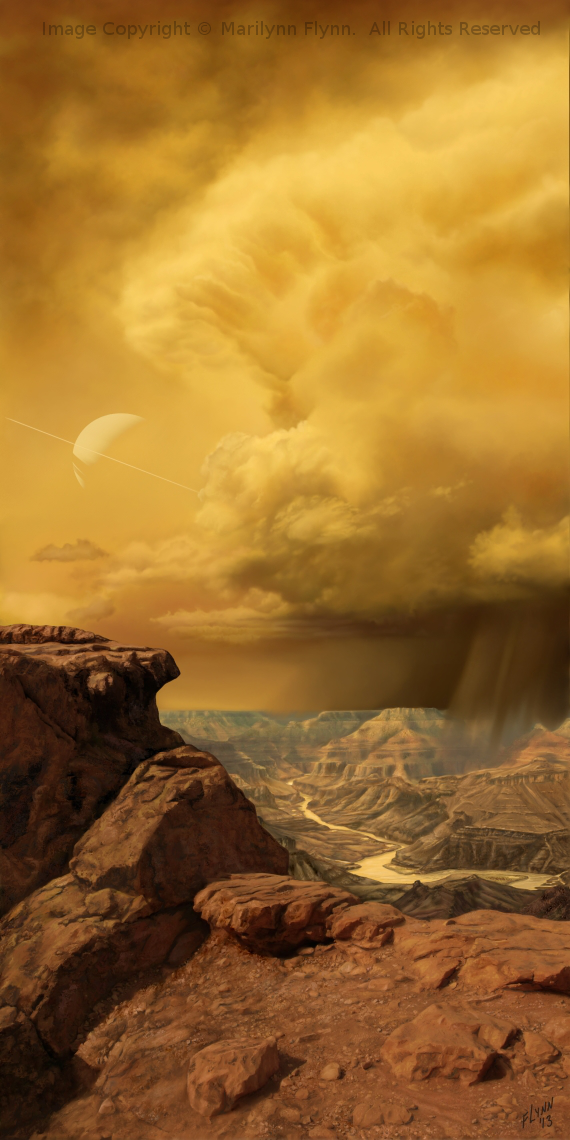
Titan’s Southern Summer: Cloudbursts of liquid methane rain down into a canyon on Saturn’s moon Titan, flooding a river carving a channel through layers of frozen ices and rock mixed with hydrocarbons. Space observations have noted that clouds in the southern hemisphere formed during heightened levels of sunlight during the Titanian summer and generated uplift which resulted in convection.These storms can produce methane rains that erode the surface in ways similar to the way liquid water creates canyons on Earth. Images from space have show numerous river channels on the surface of Titan, which is so cold that water plays the role of rock and lava, and flowing methane cuts river channels that fill great lakes with liquid natural gas.This view is a narrow angle 30* FOV seen from Titan’s southern hemisphere at about -60* South Latitude, 320* Longitude. ©2013
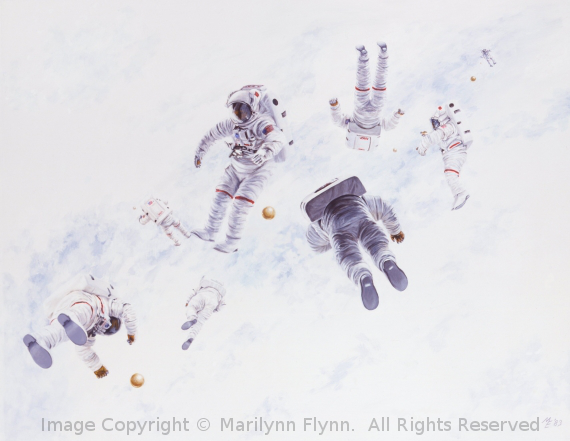
Tumbling Astronauts: Astronauts falling, or playing? And what are the golden orbs? I like to let the viewer imagine what this image represents. ©1983

Cosmic Cauldron: This was the painting which flew on the Mir Space Station as part of “Ars Ad Astra“, the first art exhibit in Earth orbit. Humankind is now aware that the Earth is not at the center of the universe. However, as it is their birthplace, humanity will always regard the Earth as central, and above the rest of the Universe in
importance. Against a backdrop representing the expanding golden energy of the primordial universe after its creation, the Earth hovers over the bowl of the universe. Humans have encircled their home planet with objects they have created — tools to discover that which created them. The planets of primary importance to humanity, the Moon and Mars, hover nearby. Other planets await exploration in the far distance. © 1995
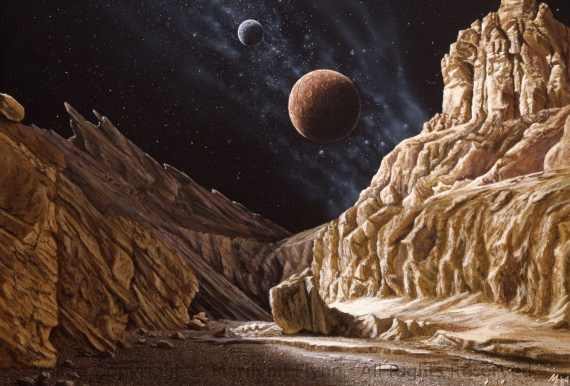
Rigel Kentaurus Canyon: An imaginary canyon of another star system. This was based on an area in Death Valley that I visited during the first space art workshop, where the IAAA was formed. © 1984

Visit Valles Marineris: Tourists of the future admire the awesome vista from the edge of Valles Marineris, the “Grand Canyon of Mars”. Although formed differently, and much larger than the Grand Canyon of Arizona, this giant Martian rift would also offer spectacular views for visiting sightseers. In this painting, inspired by retro travel posters, the astro-tourists stand near an unusual rock formation just beyond the rim, on the right. Perhaps this natural sculpture, known as a ‘hoodoo’ on Earth, was shaped and eroded by winds howling through the canyon. ©2012

Lava Lake on Io: Mountains on Io may be made of silicate materials rather than sulfur. In this scene, a lava flow pours past a silicate mountain into a lake of molten sulfur. A small, geyser-like eruption also feeds material into the lake. ©1988
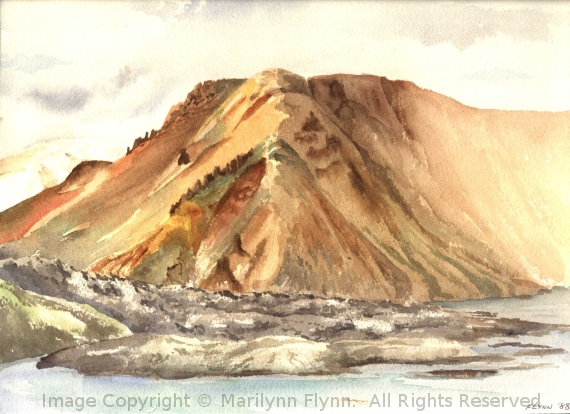
Iceland Trip Sketch: This is the on-site sketch I did in Iceland which I later turned into the above painting “Lava Lake on Io”. Just to show how a reference painting from one of our field trips was turned into a final space art painting.
Marilynn’s work can be found (and purchased) on her website – Tharsis Art Works – and on the Fine Arts America website.
Marilynn’s other work – air tanker art (aerial fire-fighting) can be found here and steampunk related art can be found on Artellus Artworks.











New York Travel Services – World travel info, including the New York area activities, accommodations, and travel arrangements.
Thank you all for the kind comments and it’s always amazing to be compared with the great Chesley B. I was also greatly influenced by Ludek Pesek and Ron Miller.
Dave, I was fortunate to have my work published in your beautiful book! And you are right – “I Love an Astronaut” was a self portrait of myself and my late husband.
John, I would love to do some more magazine covers. I used to do print illustrations but it’s been a long time since I chased down any of the publishers. Will have to put it on my ‘to do’ list!
Marilynn Flynn/Tharsis Artworks
Yeah, I can see the Ron Miller influence, now that you mention it, MariLynn. Another great stfnal artist who does not get much mention nowadays.
I was fortunate to be able to use some of these beautiful paintings for my book ‘Visions of Space’. I believe that ‘I love an astronaut’ was actually a self-portrait, with Marilynn’s late husband Mike; she always wanted to be an astronaut herself but this was as close as she could get! (BTW, the correct spelling is ‘Bonestell’ 😉 He also inspired me back in the 50s, as h did many members of the IAAA. . .)
The first thought that crossed my mind while looking at these was that some of them are very reminiscent of, if not directly influenced by, Chesley Bonestall, who created marvelous cover art for the professional magazines during the 1940s and 1950s. To be compared in that company -as in the artist for whom the Chesley Awards for Excellence in Science Fiction Art (awarded annually at the World Convention) are named – is quite a compliment. I will keep my eyes open for more work from Marilynn Flynn in the future.
Gorgeous artwork. This is absolutely amazing. The detail in Marilynn Flynn’s paintings also feels reminiscent of the Victorian artist John Brett: https://www.tate.org.uk/art/artworks/brett-glacier-of-rosenlaui-n05643.
That certainly is good art–comparable to the best of science fiction art, for example, Chesley Bonnestell. I wish she would do some covers for the magazines, but I imagine she’d charge them about a zillion dollars after having her art on television.